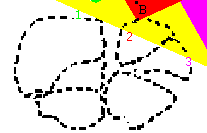 Home
Home  Up
Up  Search
Search  Mail
NEW
Mail
NEW
Alignment of chamber top hole at Newgrange
Like the roof box at Newgrange, the top hole of the chamber
(normally
covered
by the capstone) could also have an archaeoastronomical meaning.
Look
at
the following figure:

The red color depicts the measurements (the red rectangular
ACDE
is the projection of the top hole under the capstone on the ground
plan)
made during my visit at Newgrange on Dec. 20, 1996:
- height (h) difference between the underside of the cap stone
and
top
plane
of the basin in the central recess (B) is around 6150 +/- 100
[mm]
(including
an approximated lowering of the roof in time by 500 [mm]
[O'Kelly
(1982),
page 120]).
- distance between the most southern corner of the top hole (A)
and
the
stone
C8 (B) is 4610 +/- 100 [mm].
- the top hole has a dimension of 915 x 750 x 1000 x 1000 +/- 40
[mm] (AC
x AD x CE x DE). Point E has not been determined directly, but
by using
a photograph.
Look how close point A is to the main path of the winter solstice
sun!
- AC
is turned some -30o +/- 1o from the main
passage
azimuth and AD is some 65o +/- 1o turned
from the
main passage azimuth.
- there is no blockage of the light going from the top hole
under
the
capstone
(A) towards C8 (B).
- the passage azimuth (azipas)
is around 135o
+/- 1o
(Tim O'Brien, 1996, pers. comm)
O'Kelly (1982) is showing in his pictures something about 148o
- 150o. This is not correct. According to Tim O'Brien,
O'Kelly
has acknowledged this error.
All the (red) dimensions have been measured by using a 2D
water leveled laser pointer and detailed maps of O'Kelly.
Taking this into account, we get the following information
with
regard to the light patches in the central recess at the level of
the
top
of the basin during summer solstice day on 3050 BC:

The size of the picture is: 2080 x 1400 [mm]
The error in the
colored
pixels
in x and y direction are: +/- 150 [mm]
Description of the colors:
- Green
Light patch around 10:10 GMT
- Red
Light patch around 10:30 GMT
- Purple
Light patch around 11:00 GMT
- Yellow
Everything that will be covered with light during the above time
period
(including the inaccuracy of +/ 150 [mm]).
- Black
The contours of the broken basin in the central recess.
To get this effect the capstone should have been removed or just
have
been
moved to allow for a small light patch, which could have been
possible
during the time the cairn material was not yet fully covering the
capstone
area.
So to summarize: The sun shines through this top hole under the
capstone
some 30 days before and after the longest day on the plane of the
basin.
During the longest day it will shine some 50 minutes on this
plane, if
there was only a small aperture through the top hole.
Just for comparison, the sun shines through the roof box (at
winter
solstice) some 5 days before and after the shortest day in the
chamber
and during the shortest day it will shine some 15 minutes in the
chamber.
Another remarkable thing is; the altitude of A with regard to
B is 53o 9' has almost the same value as the latitude
of
Newgrange
(53o 42'), so (is there logic behind this so?)
every
day one can see at a certain moment, through the top hole, the
ecliptic.
Conclusions
It looks like that there could be an alignment between the top hole
and
the basin in the central recess of Newgrange. The above information
was
not determined with very small inaccuracies, but even the present
inaccuracies
provide a good general idea.
A circular cone of stones over
the
chamber
can be seen up to the level of the capstone. This could indicate
that
some
time the chamber was covered with a nice circular cone of stones
which
let the capstone almost free.
Remember that, as somebody said, every roof is pointed towards
the
heaven
and thus would possibly allow the high/midday summer solstice sun
inside.
This is true of course (you can also see this, due to the small
influence
in the direction of the passage and the height of the chamber), so
this
top hole-basin alignment is of course no proof. The likelihood of
an on
purpose alignment is higher, because there are more alignments in
this
monument and other monuments and there are alignments towards
other
buildings
in the neighborhood.
Another increase of likelihood is if the same phenomena is seen in
other corbelled roof. It is a pity that not many corbelled roofs
survived
the years. Looking at data on Knowth,
the
top
hole of Knowth also seems to act in the same way. If there exist
more
original
corbelled roofs, please let me
know.
Acknowledgments
I thank Clare Tuffy, custodian of Newgrange, for allowing me to do
the
measurements.
Other sources
Through the custodian of Newgrange, I got into contact with Gerry
Bracken,
Ireland (Pers. comm. [1998]). He had done, between 1991 and 1993,
comparable measurements
with
regard to the top hole under the capstone. The difference between
his
work
and mine is that he thought that the light would shine in the right
recess
chamber (which will not happen, in my opinion).
Jacqueline I. Garnett and her husband also have investigated the top
hole for Newgrange in the end 1970's (Garnett, [2005]),
to determine what stars can be visible from the recesses. This to
related the sky view with the megalithic art in the monument.
Disclaimer and Copyright
 Home
Home  Up
Up  Search
Search  Mail
Mail
Major content related changes: August 22, 1997

